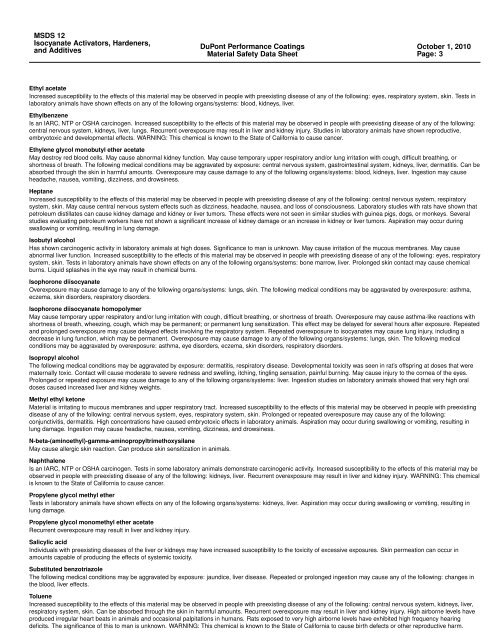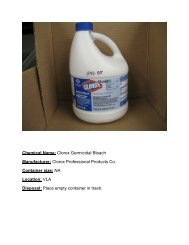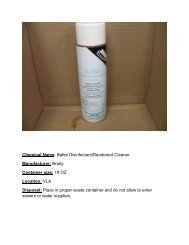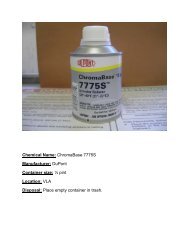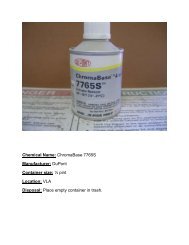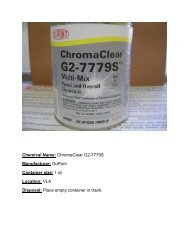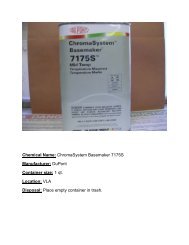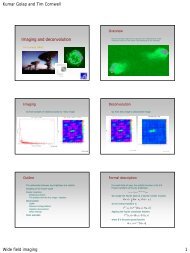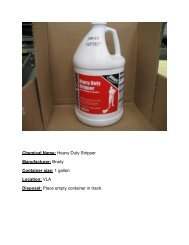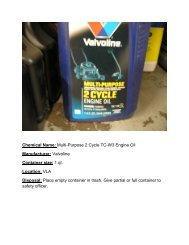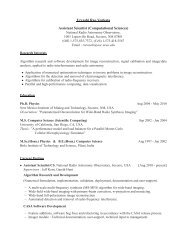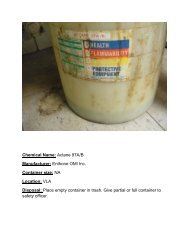Du Pont ChromaSystem Basemaker 7160S
Du Pont ChromaSystem Basemaker 7160S
Du Pont ChromaSystem Basemaker 7160S
Create successful ePaper yourself
Turn your PDF publications into a flip-book with our unique Google optimized e-Paper software.
MSDS 12<br />
Isocyanate Activators, Hardeners,<br />
and Additives<br />
<strong>Du</strong><strong>Pont</strong> Performance Coatings<br />
Material Safety Data Sheet<br />
October 1, 2010<br />
Page: 3<br />
Ethyl acetate<br />
Increased susceptibility to the effects of this material may be observed in people with preexisting disease of any of the following: eyes, respiratory system, skin. Tests in<br />
laboratory animals have shown effects on any of the following organs/systems: blood, kidneys, liver.<br />
Ethylbenzene<br />
Is an IARC, NTP or OSHA carcinogen. Increased susceptibility to the effects of this material may be observed in people with preexisting disease of any of the following:<br />
central nervous system, kidneys, liver, lungs. Recurrent overexposure may result in liver and kidney injury. Studies in laboratory animals have shown reproductive,<br />
embryotoxic and developmental effects. WARNING: This chemical is known to the State of California to cause cancer.<br />
Ethylene glycol monobutyl ether acetate<br />
May destroy red blood cells. May cause abnormal kidney function. May cause temporary upper respiratory and/or lung irritation with cough, difficult breathing, or<br />
shortness of breath. The following medical conditions may be aggravated by exposure: central nervous system, gastrointestinal system, kidneys, liver, dermatitis. Can be<br />
absorbed through the skin in harmful amounts. Overexposure may cause damage to any of the following organs/systems: blood, kidneys, liver. Ingestion may cause<br />
headache, nausea, vomiting, dizziness, and drowsiness.<br />
Heptane<br />
Increased susceptibility to the effects of this material may be observed in people with preexisting disease of any of the following: central nervous system, respiratory<br />
system, skin. May cause central nervous system effects such as dizziness, headache, nausea, and loss of consciousness. Laboratory studies with rats have shown that<br />
petroleum distillates can cause kidney damage and kidney or liver tumors. These effects were not seen in similar studies with guinea pigs, dogs, or monkeys. Several<br />
studies evaluating petroleum workers have not shown a significant increase of kidney damage or an increase in kidney or liver tumors. Aspiration may occur during<br />
swallowing or vomiting, resulting in lung damage.<br />
Isobutyl alcohol<br />
Has shown carcinogenic activity in laboratory animals at high doses. Significance to man is unknown. May cause irritation of the mucous membranes. May cause<br />
abnormal liver function. Increased susceptibility to the effects of this material may be observed in people with preexisting disease of any of the following: eyes, respiratory<br />
system, skin. Tests in laboratory animals have shown effects on any of the following organs/systems: bone marrow, liver. Prolonged skin contact may cause chemical<br />
burns. Liquid splashes in the eye may result in chemical burns.<br />
Isophorone diisocyanate<br />
Overexposure may cause damage to any of the following organs/systems: lungs, skin. The following medical conditions may be aggravated by overexposure: asthma,<br />
eczema, skin disorders, respiratory disorders.<br />
Isophorone diisocyanate homopolymer<br />
May cause temporary upper respiratory and/or lung irritation with cough, difficult breathing, or shortness of breath. Overexposure may cause asthma-like reactions with<br />
shortness of breath, wheezing, cough, which may be permanent; or permanent lung sensitization. This effect may be delayed for several hours after exposure. Repeated<br />
and prolonged overexposure may cause delayed effects involving the respiratory system. Repeated overexposure to isocyanates may cause lung injury, including a<br />
decrease in lung function, which may be permanent. Overexposure may cause damage to any of the following organs/systems: lungs, skin. The following medical<br />
conditions may be aggravated by overexposure: asthma, eye disorders, eczema, skin disorders, respiratory disorders.<br />
Isopropyl alcohol<br />
The following medical conditions may be aggravated by exposure: dermatitis, respiratory disease. Developmental toxicity was seen in rat’s offspring at doses that were<br />
maternally toxic. Contact will cause moderate to severe redness and swelling, itching, tingling sensation, painful burning. May cause injury to the cornea of the eyes.<br />
Prolonged or repeated exposure may cause damage to any of the following organs/systems: liver. Ingestion studies on laboratory animals showed that very high oral<br />
doses caused increased liver and kidney weights.<br />
Methyl ethyl ketone<br />
Material is irritating to mucous membranes and upper respiratory tract. Increased susceptibility to the effects of this material may be observed in people with preexisting<br />
disease of any of the following: central nervous system, eyes, respiratory system, skin. Prolonged or repeated overexposure may cause any of the following:<br />
conjunctivitis, dermatitis. High concentrations have caused embryotoxic effects in laboratory animals. Aspiration may occur during swallowing or vomiting, resulting in<br />
lung damage. Ingestion may cause headache, nausea, vomiting, dizziness, and drowsiness.<br />
N-beta-(aminoethyl)-gamma-aminopropyltrimethoxysilane<br />
May cause allergic skin reaction. Can produce skin sensitization in animals.<br />
Naphthalene<br />
Is an IARC, NTP or OSHA carcinogen. Tests in some laboratory animals demonstrate carcinogenic activity. Increased susceptibility to the effects of this material may be<br />
observed in people with preexisting disease of any of the following: kidneys, liver. Recurrent overexposure may result in liver and kidney injury. WARNING: This chemical<br />
is known to the State of California to cause cancer.<br />
Propylene glycol methyl ether<br />
Tests in laboratory animals have shown effects on any of the following organs/systems: kidneys, liver. Aspiration may occur during swallowing or vomiting, resulting in<br />
lung damage.<br />
Propylene glycol monomethyl ether acetate<br />
Recurrent overexposure may result in liver and kidney injury.<br />
Salicylic acid<br />
Individuals with preexisting diseases of the liver or kidneys may have increased susceptibility to the toxicity of excessive exposures. Skin permeation can occur in<br />
amounts capable of producing the effects of systemic toxicity.<br />
Substituted benzotriazole<br />
The following medical conditions may be aggravated by exposure: jaundice, liver disease. Repeated or prolonged ingestion may cause any of the following: changes in<br />
the blood, liver effects.<br />
Toluene<br />
Increased susceptibility to the effects of this material may be observed in people with preexisting disease of any of the following: central nervous system, kidneys, liver,<br />
respiratory system, skin. Can be absorbed through the skin in harmful amounts. Recurrent overexposure may result in liver and kidney injury. High airborne levels have<br />
produced irregular heart beats in animals and occasional palpitations in humans. Rats exposed to very high airborne levels have exhibited high frequency hearing<br />
deficits. The significance of this to man is unknown. WARNING: This chemical is known to the State of California to cause birth defects or other reproductive harm.


